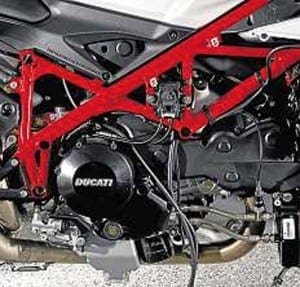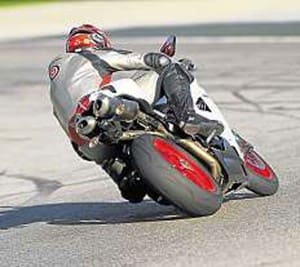It’s slightly strange to be at the launch of a bike that’s already been in showrooms for a couple of months. But when the venue is Imola, the bike is a hot new Vtwin and the sun is shining, it’s definitely a case of better late than never.
And it’s easy to understand why Ducati took the trouble to organise a press event for the 848 EVO, even if rival commitments and circuit availability necessitated a slight delay. A middleweight eight-valve V-twin has been an important part of the Bolognese line-up ever since the 748 was launched in 1995, and the 848 has been the most successful of them all since its launch three years ago.
Its importance is greater than mere sales figures might suggest too, because the smaller hyper-sport bike is an entry point to the Ducati brand for many riders who later progress to the larger capacity models. “80% of 848 customers are new to Ducati, mainly from Japanese 600s but a lot from naked bikes too,” says ProductManager Paolo Quattrino.
 What’s different?
What’s different?
The EVO justifies its name by being a significant evolution. Its 849cc, DOHC eight-valve engine is tuned for more top-end power, and the chassis is uprated with a new front brake and the addition of a steering damper (more on that later). Most of the changes are to the liquid-cooled desmo motor, which has revised combustion chambers and new pistons that help raise compression ratio to 13.2:1 (from 12:1).
The inletports are redesigned,andnew camshafts give extra valve lift. The elliptical throttle bodies are larger, with equivalent of 60mm instead of 56mm diameters. The result is a 6bhp increase to 140bhp at 10,500rpm. The power curve is slightly down to 9000rpm, then stronger fromthatpoint to the 11,000rpm limit. Like the previous model, the EVO differs from larger super-sports desmos by having a wet clutch.
Apart from its matt white (or Stealth matt black) paintwork the bike is almost indistinguishable from the 1198, because its front brake calipers have been upgraded to Brembo’s monoblocs from the conventional four-pot units. The new steering damper is in the familiar transverse position and is nonadjustable. And the rubber is Pirelli’s new Supercorsa SP, the rear remaining a 180/55 rather than the 1198’s 190.
 What’s it like to ride?
What’s it like to ride?
The look might be the same, but there’s a distinctly different sound and feel to the EVO. At 168kg it weights exactly the same amount as the 1198SP, its seat height is identical at 820mm, and the digital instrument panel is borrowed too.
But on the hilly and spectacular Imola track the most obvious difference was clear, as the EVO demonstrated a more rev-happy nature than its 848 predecessor, never mind the 1198.
The 848 has always had a frenetic nature that demanded precise riding, and that’s truer nowthan ever. The EVO motor delivers its peak torque 1500rpm higher than before, at 9750rpm. Lacking the midrange heft of the 1198, and with shorter gearing, the EVO had to be kept on the boil withmore frequent use of the gearbox.
Unfortunately this was a slight drawback inmyfirst two sessions, as the gear change seemed slightly notchy, and occasionally required a second prod of the lever to engage on upchanges. For the next session I had the lever moved downa touch, which cured the problem.



